Insights from the OpenTelemetry Contributor Experience Survey
The OpenTelemetry Contributor Experience SIG recently surveyed the community to learn what it’s like to contribute to the project and what we can do to improve the contributor experience. The Contributor Experience Survey asked contributors for their thoughts about the project’s organization, SIG contributions, leadership committee interactions, and event attendance. We received 120 responses and heard from all 47 Special Interest Groups (SIGs). We’ll use this feedback to make contributing to OpenTelemetry easier and more rewarding. A big thank you to everyone who participated in the survey! Let’s review the results.
Key takeaways
We conducted this survey to learn what the project can do better. Here are the key things we learned, along with areas we can improve for contributors:
- Getting started: 48% of newer contributors don’t confidently know how to get started. Intra- and inter-SIG communication and contributing guides need improvement.
- SIG meetings: 82% of contributors find SIG meetings useful. Meeting attendance correlates to greater knowledge about navigating and contributing to the project, but some dislike the synchronicity meetings require.
- Workflows: More than half of contributors do not receive timely feedback on their contributions. They also experience project tooling headaches and gatekeeping bottlenecks.
- Project and subproject priorities: Less than half of maintainers can confidently say they know the priorities of OpenTelemetry’s leadership committees. Contributors also say that it’s difficult to find subproject priorities.
- Events: Contributors want more in-person events that are focused on collaboration rather than talks.
Detailed insights
With a total of 42 questions, this survey covered the breadth of the OpenTelemetry contributor experience. In this section, we analyze the responses and summarize what we learned.
In some categories, the sample size is quite small and therefore the margin of error is high. We have included the number of responses in parentheses wherever possible.
For our analysis, we treated self-reported data as true and combined “agree” with “strongly agree” responses, as well as “disagree” with “strongly disagree.” So when we say, for example, “contributors who attend SIG meetings are far more likely to know how to begin contributing in any SIG,” what we mean is that contributors who agreed or strongly agreed that they regularly attend SIG meetings are more likely to agree or strongly agree that they know how to get started contributing.
About the respondents
We heard from 120 contributors, including 45 maintainers and at least one contributor from each SIG. Here’s more about our respondents:
- 63% work for an observability vendor.
- 20% have been contributing for less than six months.
- 86% live in North America (45%) or EMEA (41%). These numbers roughly match our calculations of 39% and 43% respectively, after classifying the devstats country statistics into regions.
- 43% contribute on their own time.
- 71% are members of the OpenTelemetry organization.
Project organization
We asked contributors to tell us how they feel about organizational and operational aspects of the OpenTelemetry project. Do they know how to get started? Can they solve problems on their own? Are SIG meetings useful?
Knowing how to get started in a large open source project like OpenTelemetry is challenging. We focused on our newest contributors, those who’ve participated in the project for less than two years, to see how the project’s onboarding processes stand up. Of the 56 respondents in this category, just over half know how to get started in any OpenTelemetry SIG. But that leaves 48% of newer contributors who do not confidently know how to get started. Work is underway to improve contributing guidelines across the project, but there is clearly room to improve the OpenTelemetry contributor onboarding experience.

One way we can potentially improve the onboarding experience is to encourage new contributors to attend SIG meetings. Of respondents who answered the question, 82% find SIG meetings useful. Further survey analysis confirmed the usefulness of meetings.
For example, we found that contributors who regularly attend SIG meetings are far more likely to know how to begin contributing in any SIG.
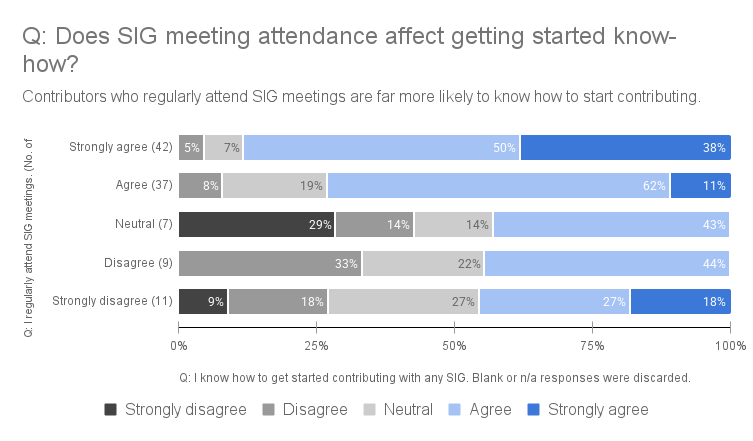
Attendance at SIG meetings might have other benefits as well. Those who attend are more likely to know which proposals have a greater chance of being accepted and how to contribute what they want.
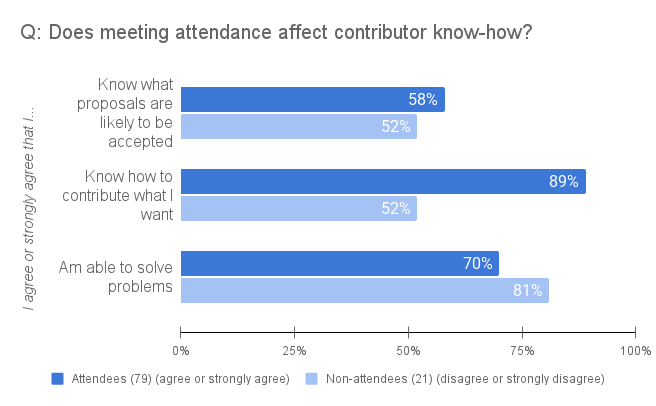
Contributing to a SIG
Contributing to open source projects like OpenTelemetry takes time: both from the contributor and the reviewer. To assess how the project is doing in its effort to provide timely feedback, we asked survey respondents about their experience. Less than half of those who answered (48 of 98 responses or 49%) receive timely feedback. When we compare those answers to how contributors feel about the thoroughness of the project’s decision making, we get the following heat map. We can loosely conclude that when contributors get timely feedback, they are more likely to find decisions thorough enough. But analyzing this data raises an important point: we don’t know what a reasonable baseline is for timely feedback in open source projects. We encourage other open source projects to run contributor surveys so we can compare their contributors’ experience with that of OpenTelemetry contributors.

The survey asked contributors whether they were ultimately able to solve problems for themselves and their users. We compared those answers to the tenure of the contributors. The results show that a greater percentage of newer contributors, those whose tenure is under 2 years, can resolve problems: 77% of newer contributors v. 65% of experienced contributors.

We received many thoughtful responses to our open-ended questions:
“Do you have any additional comments regarding project organization or your experience contributing? Is there anything you’d like to see added to or changed about the OTel contributor experience?”
The answers fell loosely into four categories: tooling, communication and documentation, meetings, and workflows.
Tooling
- Repositories need more automation.
- Build processes should be consistent across SIGs and repositories.
- The CI process in some repositories is painful and needs to be run over and over when approvals are slow.
- A single source of truth is needed for tracking code changes instead of combing through release notes.
Communication and documentation
- All SIGs should align with SIG Comms to make the official docs the go-to spot for all reference and instructional material.
- Most contributing guides need work.
- There are no good “getting started” materials for contributing components to the Collector.
- New contributors are unsure how to be helpful and add value because subproject priorities are unclear and repository issues are numerous and hard to find and understand. Some contributors choose to create a fork instead of contributing upstream.
- It is unclear which SIG should be approached for a proposal, resulting in contributors being passed from SIG to SIG.
Meetings
- Some people are unable to attend or uncomfortable attending SIG meetings.
- Meetings shouldn’t be required to advance issues or PRs that are straightforward, but often it seems that’s the only way to move the work forward.
- For those who prefer asynchronous work, meeting-driven decision-making is problematic.
Workflows
- Overburdened subprojects or components should add maintainers. Keeping the contribution experience as positive and welcoming as possible is a good way to recruit new project leaders.
- Overburdened repositories should consider adjusting write permissions.
- Reviews and discussions are painfully slow and perhaps too thorough.
- Gatekeeping by a few SIG leaders makes progress slow.
Maintainers, Technical Committee, and Governance Committee
OpenTelemetry maintainers made up 37.5% of our total survey respondents. We asked them to report on their experiences contributing in a leadership role. How autonomous do they feel? Do they have a lot of work to do to make their SIG specification-compliant? Are they supported by the Technical and Governance Committees?
Maintainers report feeling a high level of autonomy. On a scale of 1 (low) to 5 (high), none rated their autonomy lower than a 3, and 89% rated their autonomy 4 or 5.
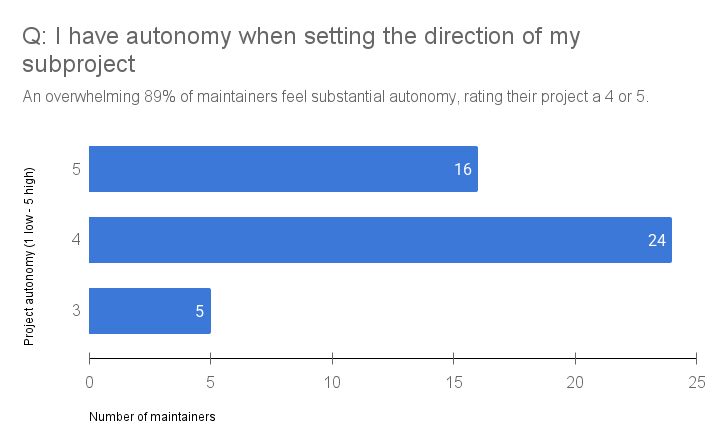
Of the 43 maintainers who answered the question about their SIG’s compliance with the OpenTelemetry specification, 16 said their SIG does not implement the specification. The remaining 27 rated their SIGs as far from, mostly, or fully compliant. Nearly 50% say their projects are mostly compliant.

Two-thirds of maintainer respondents (29 of 44) have interacted with the Technical Committee or Governance Committee, but fewer than half of them know the leadership committees’ priorities.
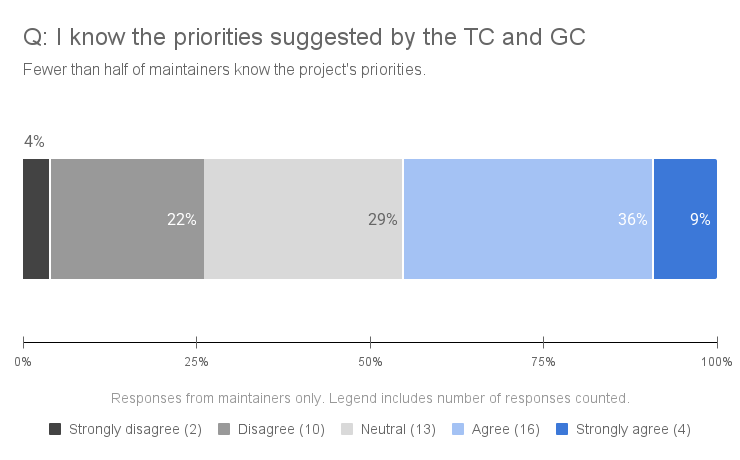
The responses to other questions relating to the Technical and Governance Committees are being compiled and analyzed separately from this blog post. We plan to present the results to OpenTelemetry maintainers and the committees in public channels in the near future.
Events
We asked respondents to tell us in their own words what kind of event would be useful for growing the project. Thirty-two contributors responded and nearly all of them said they want more in-person events. Many also specified that they’d rather use the time to collaborate with each other than listen to talks. We grouped the responses loosely into six categories. Some responses fell in multiple categories.
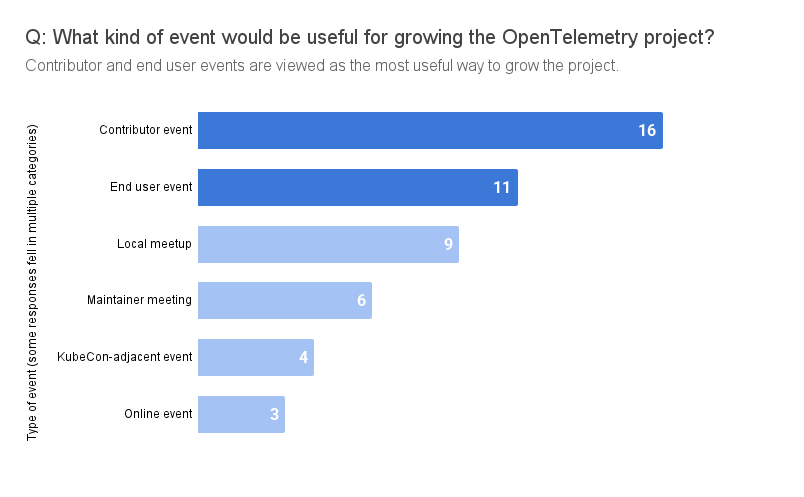
We also asked contributors about their past and future attendance at KubeCon + CloudNativeCon, the flagship conference for cloud native technologies. With the inaugural KubeCon Japan being held in June 2025, there are now 5 KubeCon conferences: China, Europe, India, Japan, and North America. Here’s what we learned about the attendance of OpenTelemetry contributors at KubeCon events.
More than half of respondents in each region of the world have attended KubeCon in the past or plan to in the future.
Percentage of respondents who have attended or plan to attend any KubeCon event
By region of residence
Asia, Pacific Islands, Australia and New Zealand (14) Central America, the Caribbean and South America (7) Europe, Africa and the Middle East (65) North America (56) 71% 57% 71% 64%
We were interested to learn which KubeCon conferences attract larger numbers of OTel attendees from outside the conference region. A total of only 5 respondents reported attendance for the KubeCon conferences in India and Japan, so we didn’t include them in the following comparison. But it is interesting to note that all 5 respondents were from regions other than APAC. Of the 3 remaining conferences, KubeCon North America has the greatest share of OpenTelemetry contributors traveling from other regions.
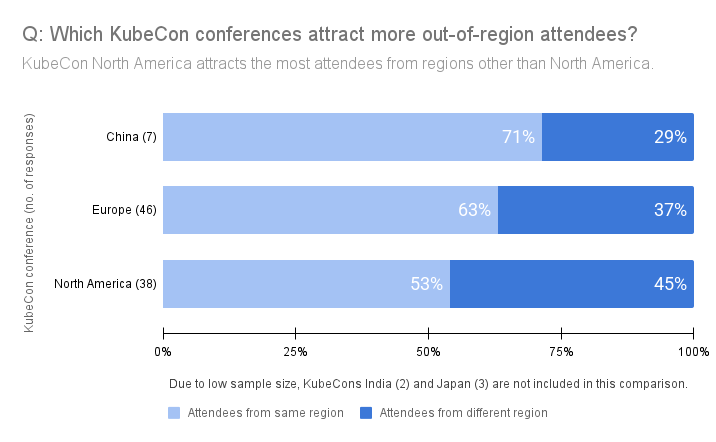
Among those respondents who have attended a KubeCon event or plan to in the future, there is overwhelming interest in a separate, dedicated OpenTelemetry contributors-only event in their region: 63 of 73 or 86% would attend such an event. By contrast, those respondents who haven’t and don’t plan to attend KubeCon have marginally less interest in attending a dedicated contributor event in their region: 34 of 46 or 74% say they’d attend.
We analyzed one final event question: If you have attended KubeCon + CloudNativeCon, have you participated in OpenTelemetry activities, including the OpenTelemetry Observatory, Contribfest or the maintainer track session? Of the 73 respondents who have attended or will attend a conference, 53 or 73% say they have also attended an OTel-specific event at least once.

Survey feedback
Finally, we asked respondents to give us feedback on the survey itself. One of the answers we received multiple times is that respondents would like a way to answer questions or give feedback about specific subprojects. We will investigate offering future surveys to address this request.
Learn more
For detailed results, see the anonymized survey responses.
Your feedback is essential
Thanks again to everyone who participated in the survey! Your feedback is crucial for guiding the future development of OpenTelemetry and ensuring it continues to meet your evolving needs. Stay connected and learn about upcoming surveys through the following channels: